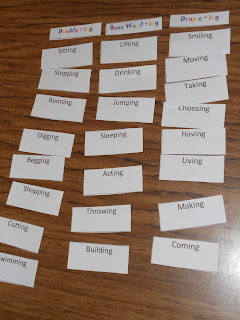GV Daily Lesson Plan
Student Name: Jessica Dow Course Title; Semester: EDUC 325; Spring 2013
Title of Lesson: Building Fluency Though Echo Reading Total Lesson Time: 30 Minutes
Grade(s): 3rd Subject Area: Literacy
This lesson is part of a unit over Building Reading Fluency
Curriculum Standard(s):
Learning Objectives and How Assessed:
Learning Objective(s)
|
Assessment Plan
|
Student will be able to:
1. Identify when to break, pause, and use expression during reading.
2. Evaluate themselves on their reading fluency using a rubric provided.
|
1. Student will read passage provided for them allowing breaks at punctuation and reading with appropriate expression.
2. Student will fill out a rubric provided by the teacher, rating their ability to read fluently, thus identifying strengths and weaknesses of student reading fluency.
|
Content Outline of the Lesson: Materials Needed:
Student will participate in Echo Reading in order to build reading fluency using the passage “A Popular Song”, chosen for him at his instructional level. Student will continue to work on the work sort of adding –ing to a word and stating the rule used in each word as he sorts them.
|
· A-Z Reading Fluency Passage “A Popular Song” Level R
· Reading Fluency Rubric
· Word Sort
|
Lesson Procedures:
|
Time
|
Differentiation (Adaptations for Diverse Learners, ELL, Gifted)
|
1. Before Reading:
**Activate Student Schema
*Review what it means to read fluently. Discuss with the student reading speed, accuracy, expression, and reading comprehension and how these components influence reading fluently.
*Review the importance of fluent reading and how it helps us to better understand what we are reading.
2. During
*Read sentences to student and have the student repeat what you read and how you read it. This will help them to recognize when to pause and how to add expression. They will also notice their ability to comprehend the text as well as that the reading sounds conversational.
*While you are reading, model fluency and expression with your voice.
*As you read, ask the student what you do when you come to a comma, period, question mark, and exclamation point. (Pause, breaks, and expression)
3. After Reading
*Have the student fill out the rubric provided on how he feels his reading fluency is in the various categories of reading fluency.
*Use this information to discuss what the child would like to continue to work on.
*Identify strengths and weaknesses to the student. Make suggestions to on what you feel the student should continue to focus on.
*Set a goal together, deciding what aspect you both feel the student should continue to focus on.
4. Word Work
*Complete the –ing word sort.
*Have the child arrange the words using the headings.
*Allow the child to complete the word sort with as much time as needed.
*Have the student explain why each word belongs in each column and how that word follows the rule he places it under.
*Review drop e add –ing, doubling final consonant and add –ing, and adding –ing to the base word.
5. Closure
*Quickly review what to do when you come to a period, comma, question mark, or exclamation mark in your reading.
*Review the meaning of reading fluency and how it helps us to better understand what we read.
*Restate the area and goal that you and the student set to continue to build reading fluency.
|
5 Min
10 Min
7 Min
5 Min
3 Min
|
*This lesson is specifically created to fit the individual needs of this child. Therefore, there is no need for further differentiation.
|
References:
Reading A-Z
|
Reflection on Student Learning:
Through the teaching of this lesson, I have learned that it is important for children to critique their own work so that the teacher can see what the student feels they are producing. Through the fluency rubric, my student was able to recognize that he lacks expression in his reading and that his reading does not sound like he is talking to a friend. I also learned that many students can benefit from echo reading techniques in regards to fluency. After reading a phrase, my student repeated the phrase back to me exactly as I had read it. This was the first time that my student read loud enough for me to clearly understand him and also the first time that he read with any fluctuation in his voice.
My student was quick to recognize how to incorporate reading fluently into anything we were reading. Suddenly, when reading other texts he was reading with expression and correct phrasing. This student is becoming more competent with the word sort we have been working on. He is now able to explain the rules to adding –ing to a word as well as why we follow these rules.
We completed this session by setting a goal. Goals are important for students so that they know what they should be working on. Setting goals should be measurable and include short term and long term goals. Because this is one of our last meetings, we decided to simply pick an area to focus on when reading aloud on his own in the future as I will no longer be a key support system for this student. We decided that expression would be the best area for him to continue to work on. He will continue to be aware of his expression while reading and strive to make his reading sound conversational.


